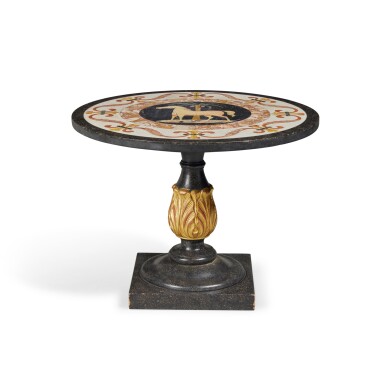Design 17/20: Furniture, Silver & Ceramics
Design 17/20: Furniture, Silver & Ceramics

Property of a Private Collection, Palm Beach
A Circular Specimen Marble Table Top by J. Darmanin & Sons, Malta, Mid-19th Century
No reserve
Lot Closed
October 18, 08:15 PM GMT
Estimate
3,000 - 5,000 USD
Lot Details
Description
A Circular Specimen Marble Table Top by J. Darmanin & Sons, Malta, Mid-19th Century
bearing a fragmentary label; now mounted as a low table on a gilt and ebonised wood baluster column base
height 20 in.; diameter 26 1/2 in.
50.8 cm; 67.3 cm
The technique of inlaid marble mosaic work had been introduced to Malta in the 17th Century by the order of the Knights Hospitaller of St John, who recruited Italian craftsmen to produce and install tombstones for their conventual church in Valetta. Many of them settled permanently on the island and founded workshops to supply marble monuments and pavements for parish churches and secular clients. The leading workshop in the 19th century was J. Darmanin & Sons, founded by Giuseppe or Joseph Darmanin (1779-1863). Malta had become a British Crown Colony in 1813 and was a popular stopping-off point for travellers en route to the Levant. Darmanin took advantage of this new influx of visitors by diversifying production at his workshop in Strada Levante to include specimen marble table tops similar in style to those avidly acquired by Grand Tourists to Italy. Darmanin & Sons regularly participated in international fairs in London and Paris between 1851 and 1886, receiving medals at the London Exhibitions of 1851 and 1862, and the firm continued trading under various family descendants until the Second World War.
The iconography of a horse under a palm tree is an emblem of ancient Carthage, a reference to Malta's history as a colony of Carthage, part of the Phoenician Empire of Antiquity. It seems to have been one of the workshop's more desirable motifs as it appears on numerous occasions in Darmanin's output. In 1839 Lady Montefiore recorded her visit to Darmanin's 'ornamental marble-works [...] they appear to be imitations of Florentine mosaic. M- ordered a small round table of the horse and palm tree' (cited in Kate Hay, 'Mosaic Marble Tables by J. Darmanin & Sons of Malta,' Furniture History XLVI, 2010, p.166). Surviving examples of marble tops incorporating the Carthaginian horse motif as a compositional element include a rectangular table from the Drue Heinz collection sold Christie's London, 4 June 2019, lot 131; a pair of serpentine tops supplied to Charles William, 3rd Marquess of Londonderry (1778-1854) at Wynyard Park, Co. Durham, sold Sotheby's London, 26 November 2003, lot 23 and again Christie's New York, 27 September 2007, lot 300, and a round scagliola top with the coat of arms of the British Monarchy in the Royal Collection (RCIN 20591).
You May Also Like










